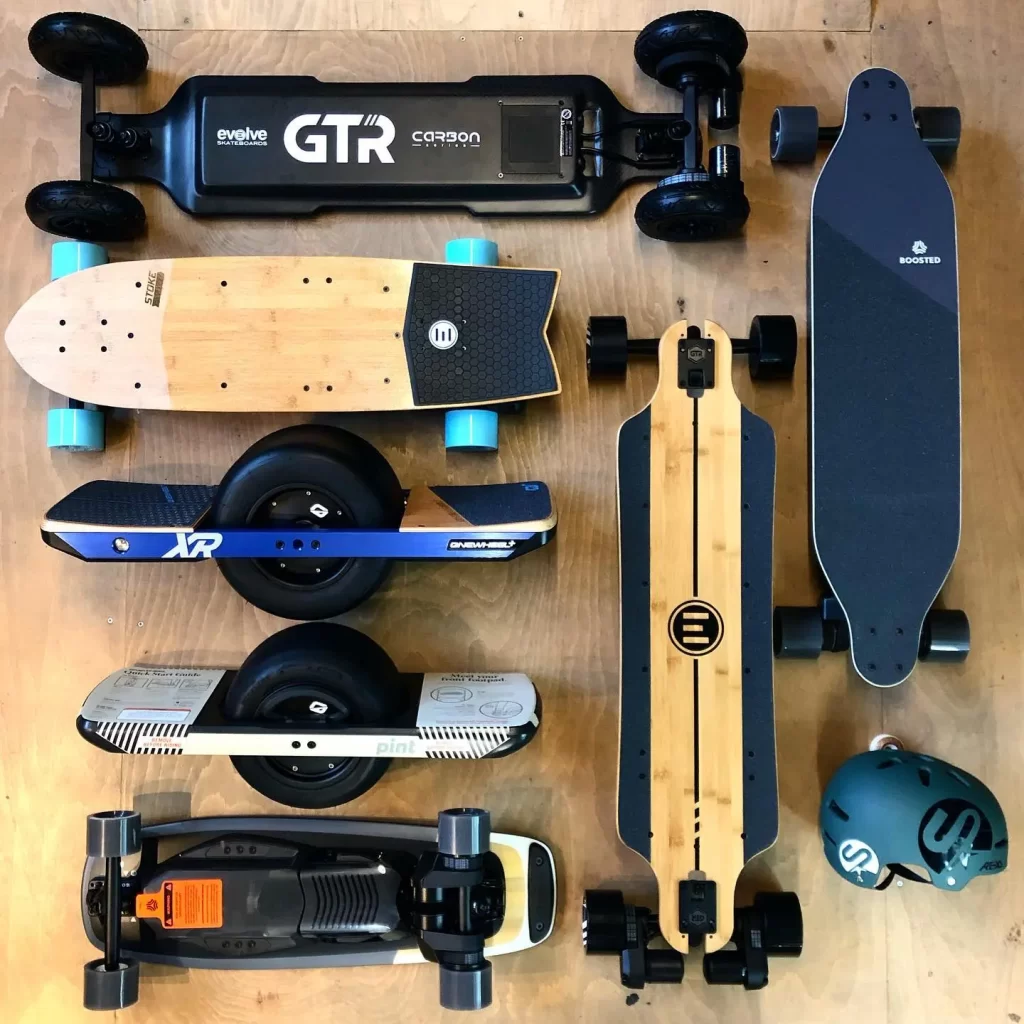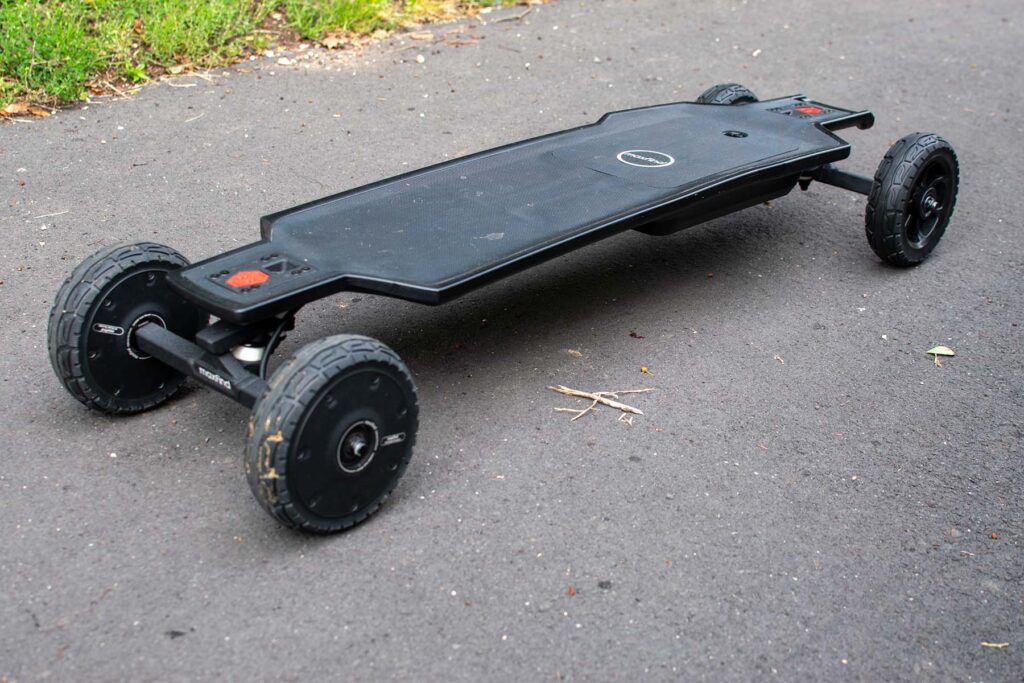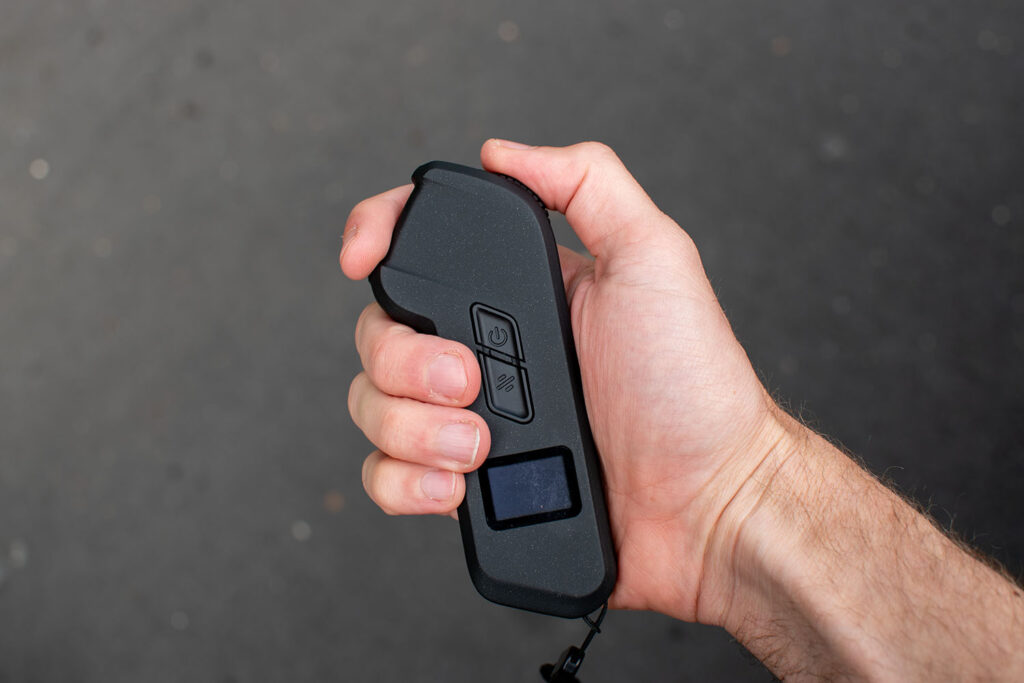The Onewheel, a novel electric vehicle, features a single large wheel centrally placed under the board, offering a unique riding experience akin to snowboarding or surfing on land. It's controlled intuitively through body movements, where riders lean and shift their weight to steer. This design emerged from the vision of Future Motion Inc., founded by Kyle Doerksen, with the first Onewheel introduced in 2014. Over time, it has evolved with improved battery life, speed, and adaptability to various terrains, gaining popularity among those seeking an innovative and exhilarating mode of travel.

The Onewheel is an innovative personal electric transportation vehicle that closely resembles an electric skateboard but offers a unique riding experience, more akin to snowboarding on fresh powder. This is primarily due to its design, which features a single, large wheel centrally located under the board. Unlike traditional electric skateboards, this design allows for a smooth ride over various terrains, including hiking tracks, grass, or sand.
The Onewheel's design and technology have transformed personal mobility, providing a unique combination of excitement and practicality for urban commuting and off-road adventures.

An electric skateboard is a board equipped with an electric motor, providing a unique blend of traditional skateboarding and technological innovation. They're a convenient and relatively fast way to get around, particularly popular for urban commuting.
Material: Electric skateboards typically have multi-layer wood decks, though aluminum, steel, and carbon-fiber decks have been introduced later.
Electronic Speed Controller (ESC): This is vital for varying the motor speed for accelerating or braking. Modern ESCs offer advanced features like motor and battery protection, regenerative braking, and customizable acceleration/deceleration curves.
Trucks: These durable parts are mounted under the skateboard, with various types (TKP, RKP, DKP, Channel trucks, 3-link trucks) catering to different stability and turning needs.
Drivetrains: Common types include hub drive, direct drive, belt drive, and gear drive, each offering specific advantages for power transmission and rider experience.
Safety: Modern electric skateboards can reach top speeds of 20-25 mph, with more powerful models exceeding 50 mph. Safety gear is highly recommended due to the risks associated with high-speed riding.
Early Days: The earliest iterations of electric skateboards in the 1970s ran on lead-acid batteries, offering limited range and speed. The first motorized skateboard, MotoBoard, was gasoline-powered and faced bans due to noise and pollution.
Pioneering Innovations: In the late 1990s, Louie Finkle introduced the wireless electric skateboard, a significant technological leap forward.
Modern Era: The advent of more powerful electric motors and batteries significantly increased skateboard design and development. Kickstarter campaigns, like the one by Boosted Boards in 2012, played a key role in popularizing modern electric skateboards.
Current Market Trends: Today's electric skateboards offer impressive features like top speeds over 24 mph, long battery life, durable and flexible decks, and polyurethane wheels for a smoother ride. They are also available in off-road versions, known as all-terrain electric skateboards, equipped with powerful motors and large, treaded, rubber pneumatic tires for rugged terrains.
Modern electric skateboards represent the culmination of decades of innovation, offering a blend of convenience, speed, and the thrill of skateboarding with the added benefits of electric power.
Several key differences emerge when comparing Onewheels and electric skateboards, particularly in control mechanisms, terrain adaptability, and noise levels.

Onewheel: The Onewheel's control mechanism is unique and body-controlled. Riders use their body weight and movements to steer and balance on the board. This intuitive control system might feel more natural to some, resembling the experience of snowboarding or surfing. However, it also comes with a steeper learning curve for beginners.
Electric Skateboard: Electric skateboards are generally controlled using a handheld remote, allowing for precise control over speed and direction. This can be particularly beneficial for those who prefer a more traditional skateboarding experience like carving or those apprehensive about the body-responsive navigation of Onewheels.
Onewheel: Onewheels excel in off-road conditions. Their single, large wheel design allows them to have greater maneuverability through rougher terrain, such as dirt, gravel, and even snow. This makes Onewheels ideal for riders who enjoy outdoor adventures and need a board that can handle a variety of landscapes.
Electric Skateboard: While electric skateboards are adept at high speeds on smooth surfaces like asphalt and pavement, they are generally not as well-suited for off-road conditions as Onewheels. However, certain models of electric skateboards, especially those equipped with all-terrain wheels, can handle harder off-road conditions but still might struggle in narrow spaces or extremely rough terrain.
Onewheel: Onewheels are known for their quiet operation. The lack of multiple moving parts and the design of the wheel contribute to a relatively silent ride, enhancing the experience for those who prefer a more serene journey.
Electric Skateboard: In contrast, electric skateboards can produce more noise, particularly models with belt-driven motors. The sound level can vary depending on the skateboard's design and the type of motor used.
The choice between a Onewheel and an electric skateboard will largely depend on the individual rider's preferences, skills, and intended use. Onewheels offer a unique, all-terrain, and body-controlled experience, while electric skateboards provide a more traditional skateboarding feel with remote control and are generally better suited for smooth, paved surfaces.
Onewheel: Recent safety concerns have been raised regarding Onewheels. The U.S. Consumer Product Safety Commission (CPSC) has warned consumers to stop using Onewheel products due to an ejection hazard, with at least four deaths and multiple injuries reported. These incidents often involved head trauma resulting from ejection from the board. Onewheel users are encouraged to follow safety guidelines, including wearing protective gear like helmets. Future Motion has introduced a "haptic buzz" feature in some models to alert riders when they approach a situation where a crash is likely.
Electric Skateboard: While electric skateboards are considered safe with proper use, users should always wear protective gear and be aware of their surroundings to avoid accident
| Feature | Onewheel | Electric Skateboard |
|---|---|---|
| Control Mechanism | Body-controlled: Uses body weight and movements for steering and balance. | Remote-controlled: Uses a handheld remote for precise speed and direction. |
| Terrain Adaptability | Superior off-road capabilities; can handle rougher terrain like dirt and snow. | Best suited for smooth surfaces like roads and pavements; some models can handle mild off-road conditions. |
| Noise Level | Generally quieter due to design and fewer moving parts. | Can be noisier, especially models with belt-driven motors. |
| Learning Curve | Steeper learning curve, requires mastering balance and body control. | Easier for beginners, especially for those familiar with skateboarding. |
| Speed | Typically lower top speeds compared to electric skateboards. | Generally faster, with some models reaching high top speeds. |
| Portability | Compact but heavier; unique design may affect ease of carrying. | Varies by design; usually lighter and more portable than Onewheels. |
| Price Range | Generally more expensive due to advanced technology and design. | Wide price range; options available from budget to high-end models. |
Unique Riding Experience: The Onewheel offers a ride akin to snowboarding or surfing, with a self-balancing mechanism that provides an engaging challenge.
Terrain Versatility: It easily handles different terrains, making it ideal for off-road adventures and urban commuting.
Compact Design: The Onewheel is relatively compact, easy to carry, and beneficial for city dwellers.
Price: The Onewheel is generally more expensive, which may not be ideal for casual riders.
Safety Concerns: Due to its unique design, there is a steeper learning curve and an increased risk of injury. Protective gear is essential.
Limited Range: While the range has improved over the years, it still falls short compared to most electric skateboards.
Speed and Range: Electric skateboards typically offer higher speeds and longer battery life, perfect for long commutes.
Easy to Ride: The learning curve for electric skateboards is generally gentle, especially for those familiar with traditional skateboarding.
Remote-Controlled Navigation: Precision control over speed and direction is possible through a handheld remote.
Terrain Limitation: They are best suited for smooth, paved surfaces and may not perform as well in off-road conditions.
Dependency on Remote Control: The need for a remote control may be seen as a downside by some riders.
Maintenance: Electric skateboards may require more maintenance due to more moving parts like motors and polyurethane wheels.
User experiences with Onewheels, as discussed on various forums like the Electric Unicycle Forum, highlight a range of opinions. Many users love the unique riding experience, comparing it to a blend of snowboarding and skateboarding but on concrete. They appreciate the board's ability to handle different terrains and enjoy the intuitive control system. However, some mention the steep learning curve, particularly when comparing it to traditional skateboards or other electric rideables. There's also mention of the price being a significant factor, considering it as an investment, particularly for casual riders. Safety concerns due to its unique design and the limited range compared to electric skateboards are also highlighted. Despite these challenges, the overall sentiment is that the Onewheel offers a thrilling and unique riding experience that many find rewarding.
In concluding our comparison between Onewheels and electric skateboards, it's clear that the choice between these two innovative modes of personal transportation largely depends on individual needs, preferences, and lifestyles.
Onewheels offer a unique riding experience akin to snowboarding or surfing, with the ability to handle various terrains. However, they come with a higher price tag, a steeper learning curve, and recent safety concerns that necessitate careful consideration and adherence to safety guidelines. Electric skateboards, on the other hand, provide a more traditional skateboarding experience with the convenience of remote control, generally at a lower cost and easier learning curve, but with limitations in off-road capabilities.
For those looking to make an informed decision, I encourage trying out demos of both types of rides or joining community groups. Engaging with existing users and experiencing these rides firsthand can provide invaluable insights into which option best suits your needs. Whether you're seeking an exhilarating off-road adventure or a speedy, efficient mode of urban transport, both Onewheels and electric skateboards have unique offerings that cater to diverse preferences and requirements.
Remember, safety should always be a priority. Whichever option you lean towards, ensure you're equipped with the necessary safety gear and familiarize yourself with the operation and maintenance guidelines to enjoy a safe and fulfilling riding experience.
